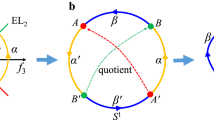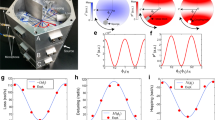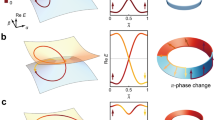Abstract
Exceptional points are a unique feature of non-Hermitian systems at which the eigenvalues and corresponding eigenstates of a Hamiltonian coalesce. Many intriguing physical phenomena arise from the topology of exceptional points, such as bulk Fermi arcs and the braiding of eigenvalues. Here we report that a structurally richer degeneracy morphology, known as the swallowtail catastrophe in singularity theory, can naturally exist in non-Hermitian systems with both parity–time and pseudo-Hermitian symmetries. For the swallowtail, three different types of singularity exist at the same time and interact with each other—an isolated nodal line, a pair of exceptional lines of order three and a non-defective intersection line. Although these singularities seem independent, they are stably connected at a single point—the vertex of the swallowtail—through which transitions can occur. We implement such a system in a non-reciprocal circuit and experimentally observe the degeneracy features of the swallowtail. Based on the frame rotation and deformation of eigenstates, we further demonstrate that the various transitions are topologically protected.
This is a preview of subscription content, access via your institution
Access options
Access Nature and 54 other Nature Portfolio journals
Get Nature+, our best-value online-access subscription
$29.99 / 30 days
cancel any time
Subscribe to this journal
Receive 12 print issues and online access
$209.00 per year
only $17.42 per issue
Buy this article
- Purchase on Springer Link
- Instant access to full article PDF
Prices may be subject to local taxes which are calculated during checkout




Similar content being viewed by others
Data availability
Source data for Fig. 3 are provided with this paper, and the datasets generated and analysed to support this study are available at https://drive.google.com/file/d/11nFGtefO8XpxqJ_hm0Ew2hRa8tVdvkl6/view?usp=share_link.
Code availability
The code used for calculation and data processing for this paper is available at https://drive.google.com/file/d/11nFGtefO8XpxqJ_hm0Ew2hRa8tVdvkl6/view?usp=share_link.
References
Kawabata, K., Shiozaki, K., Ueda, M. & Sato, M. Symmetry and topology in non-Hermitian physics. Phys. Rev. X 9, 041015 (2019).
Zhou, H. et al. Observation of bulk Fermi arc and polarization half charge from paired exceptional points. Science 359, 1009–1012 (2018).
Kawabata, K., Bessho, T. & Sato, M. Classification of exceptional points and non-Hermitian topological semimetals. Phys. Rev. Lett. 123, 066405 (2019).
Miri, M. A. & Alu, A. Exceptional points in optics and photonics. Science 363, eaar7709 (2019).
Bergholtz, E. J., Budich, J. C. & Kunst, F. K. Exceptional topology of non-Hermitian systems. Rev. Mod. Phys. 93, 015005 (2021).
Tang, W. et al. Exceptional nexus with a hybrid topological invariant. Science 370, 1077–1080 (2020).
Shen, H., Zhen, B. & Fu, L. Topological band theory for non-Hermitian Hamiltonians. Phys. Rev. Lett. 120, 146402 (2018).
Zhang, R. Y., et al. Symmetry-protected topological exceptional chains in non-Hermitian crystals. Preprint at https://arxiv.org/abs/2204.08052 (2022).
Delplace, P., Yoshida, T. & Hatsugai, Y. Symmetry-protected multifold exceptional points and their topological characterization. Phys. Rev. Lett. 127, 186602 (2021).
Wang, K., Dutt, A., Wojcik, C. C. & Fan, S. Topological complex-energy braiding of non-Hermitian bands. Nature 598, 59–64 (2021).
Xiao, Y. X. et al. Exceptional points make an astroid in non-Hermitian Lieb lattice: evolution and topological protection. Phys. Rev. B 102, 245144 (2020).
Sayyad, S., Stalhammar, M., Rodland, L. & Kunst, F. K. Symmetry-protected exceptional and nodal points in non-Hermitian systems. Preprint at https://arxiv.org/abs/2204.13945 (2022).
Wan, X., Turner, A. M., Vishwanath, A. & Savrasov, S. Y. Topological semimetal and Fermi-arc surface states in the electronic structure of pyrochlore iridates. Phys. Rev. B 83, 205101 (2011).
Young, S. M. & Kane, C. L. Dirac semimetals in two dimensions. Phys. Rev. Lett. 115, 126803 (2015).
Chiu, C. K., Teo, J. C. Y., Schnyder, A. P. & Ryu, S. Classification of topological quantum matter with symmetries. Rev. Mod. Phys. 88, 035005 (2016).
Jia, H. et al. Observation of chiral zero mode in inhomogeneous three-dimensional Weyl metamaterials. Science 363, 148–151 (2019).
Wu, Q. S., Soluyanov, A. A. & Bzdušek, T. Non-Abelian band topology in noninteracting metals. Science 365, 1273–1277 (2019).
Guo, Q. et al. Experimental observation of non-Abelian topological charges and edge states. Nature 594, 195–200 (2021).
Okuma, N., Kawabata, K., Shiozaki, K. & Sato, M. Topological origin of non-Hermitian skin effects. Phys. Rev. Lett. 124, 086801 (2020).
Helbig, T. et al. Generalized bulk–boundary correspondence in non-Hermitian topolectrical circuits. Nat. Phys. 16, 747–750 (2020).
Yao, S. & Wang, Z. Edge states and topological invariants of non-Hermitian systems. Phys. Rev. Lett. 121, 086803 (2018).
Zhong, Q. et al. Sensing with exceptional surfaces in order to combine sensitivity with robustness. Phys. Rev. Lett. 122, 153902 (2019).
Zhang, X. et al. Experimental observation of an exceptional surface in synthetic dimensions with magnon polaritons. Phys. Rev. Lett. 123, 237202 (2019).
Okugawa, R. & Yokoyama, T. Topological exceptional surfaces in non-Hermitian systems with parity–time and parity–particle-hole symmetries. Phys. Rev. B 99, 041202 (2019).
Kim, Y. et al. Dirac line nodes in inversion-symmetric crystals. Phys. Rev. Lett. 115, 036806 (2015).
Fang, C. et al. Topological nodal line semimetals with and without spin–orbital coupling. Phys. Rev. B 92, 081201 (2015).
Ahn, J. et al. Band topology and linking structure of nodal line semimetals with Z2 monopole charges. Phys. Rev. Lett. 121, 106403 (2018).
Arnol’d, V. I. Catastrophe Theory (Springer Science & Business Media, 2003).
Chandrasekaran, A., Shtyk, A., Betouras, J. J. & Chamon, C. Catastrophe theory classification of fermi surface topological transitions in two dimensions. Phys. Rev. Res. 2, 013355 (2020).
Yuan, N. F. Q. & Fu, L. Classification of critical points in energy bands based on topology, scaling, and symmetry. Phys. Rev. B 101, 125120 (2020).
Kirillov, O. N. & Overton, M. Robust stability at the swallowtail singularity. Front. Phys. 1, 24 (2013).
Raz, O., Pedatzur, O., Bruner, B. D. & Dudovich, N. Spectral caustics in attosecond science. Nat. Photon. 6, 170–173 (2012).
Gajer, P. The intersection Dold–Thom theorem. Topology 35, 939–967 (1996).
Freedman, D. Z. & Van Proeyen, A. Supergravity (Cambridge Univ. Press, 2012).
Soleymani, S. et al. Chiral and degenerate perfect absorption on exceptional surfaces. Nat. Commun. 13, 599(2022).
Acknowledgements
This work was supported by the Research Grants Council of Hong Kong through grants AoE/P-502/20, 16307821, KAUST20SC01 (to C.T.C.), and 16307621 (to H.J.). Y.Z. acknowledges financial support from National Natural Science Foundation of China grant 11701263. We acknowledge Z. Lei for helpful comments in constructing the theoretical framework. Y.Z. thanks P. Feng for assistance with visualizing various geometric configurations.
Author information
Authors and Affiliations
Contributions
H.J. and C.T.C. planned the project. J.H., Y.W., H.J. and C.T.C. designed the sample. J.H. carried out the measurements. J.H. and H.J. analysed the data. R.-Y.Z., Y.Z. and H.J. constructed the theoretical framework. J.H., R.-Y.Z., Y.Z., H.J. and C.T.C. wrote the paper. J.H., R.-Y.Z., X.O., Y.Z., H.J. and C.T.C. contributed to the discussion.
Corresponding authors
Ethics declarations
Competing interests
The authors declare no competing interests.
Peer review
Peer review information
Nature Physics thanks the anonymous reviewers for their contribution to the peer review of this work.
Additional information
Publisher’s note Springer Nature remains neutral with regard to jurisdictional claims in published maps and institutional affiliations.
Supplementary information
Supplementary Information
Supplementary Figs. 1–12, Discussion and Tables 1 and 2.
Supplementary Video 1
Swallowtail under different views.
Supplementary Video 2
Loop deformation process without changing topology.
Source data
Source Data Fig. 3
Source data for Fig. 3.
Rights and permissions
Springer Nature or its licensor (e.g. a society or other partner) holds exclusive rights to this article under a publishing agreement with the author(s) or other rightsholder(s); author self-archiving of the accepted manuscript version of this article is solely governed by the terms of such publishing agreement and applicable law.
About this article
Cite this article
Hu, J., Zhang, RY., Wang, Y. et al. Non-Hermitian swallowtail catastrophe revealing transitions among diverse topological singularities. Nat. Phys. 19, 1098–1103 (2023). https://doi.org/10.1038/s41567-023-02048-w
Received:
Accepted:
Published:
Issue Date:
DOI: https://doi.org/10.1038/s41567-023-02048-w
This article is cited by
-
Realization and topological properties of third-order exceptional lines embedded in exceptional surfaces
Nature Communications (2023)
-
Higher-order singularities in phase-tracked electromechanical oscillators
Nature Communications (2023)
-
Symmetry-protected topological exceptional chains in non-Hermitian crystals
Communications Physics (2023)
-
Symmetry gives rise to an elegant catastrophe
Nature Physics (2023)
-
Topological classification for intersection singularities of exceptional surfaces in pseudo-Hermitian systems
Communications Physics (2023)



